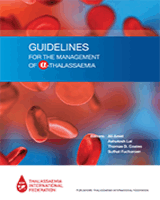From: Chapter 1, EPIDEMIOLOGY, PATHOPHYSIOLOGY AND DIAGNOSIS OF α-THALASSAEMIA

NCBI Bookshelf. A service of the National Library of Medicine, National Institutes of Health.
Peripheral blood smears of patients with HbH disease typically exhibit variable degrees of microcytic hypochromic anaemia, a distinctive feature of this condition. Figure 6 illustrates several haematological anomalies commonly observed in individuals with HbH disease, including severe hypochromia, anisocytosis (variation in cell size), poikilocytosis (abnormal cell shapes), microcytosis (small cell size), fragmentation, anisochromia (variation in cell colour), polychromasia (presence of polychromatic cells), target cells, and teardrop cells.

Red blood morphology in patients with HbH disease (Panel A and B). Red cell inclusion body is induced after the incubation of red cell with brilliant cresyl blue (Panel C).
From: Chapter 1, EPIDEMIOLOGY, PATHOPHYSIOLOGY AND DIAGNOSIS OF α-THALASSAEMIA

NCBI Bookshelf. A service of the National Library of Medicine, National Institutes of Health.